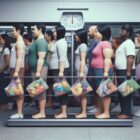4 Best Ways SNAP Contributes to Unhealthy Diets

Do you know how SNAP, the Supplemental Nutrition Assistance Program, affects your diet? It’s time to uncover the truth.
In this article, we will explore the four best ways that SNAP contributes to unhealthy diets.
Firstly, one of the main issues is limited access to healthy food options. Many SNAP recipients live in areas known as food deserts, where there is a lack of grocery stores that offer fresh fruits, vegetables, and other nutritious options. This limited access makes it difficult for individuals to make healthy choices and instead rely on processed and unhealthy foods.
Secondly, SNAP provides incentives for purchasing unhealthy foods. The program allows recipients to use their benefits to buy sugary drinks, snacks, and other high-calorie, low-nutrient foods. These incentives make it easier for individuals to choose unhealthy options over healthier alternatives.
Thirdly, there is a lack of nutrition education and guidance for SNAP recipients. Without proper knowledge about healthy eating habits and nutrition, individuals may not have the tools they need to make informed decisions about their diet. This lack of education can contribute to the consumption of unhealthy foods and the development of poor eating habits.
Lastly, the funding for healthy food choices within SNAP is often insufficient. The benefits provided by the program may not be enough to cover the cost of purchasing fresh produce and other nutritious foods. As a result, individuals may be forced to stretch their benefits by purchasing cheaper, less healthy options.
In conclusion, SNAP may be inadvertently promoting unhealthy eating habits due to limited access to healthy food options, incentives for purchasing unhealthy foods, a lack of nutrition education and guidance, and insufficient funding for healthy food choices. It is crucial to shed light on this issue and work towards finding solutions that promote better nutrition for all individuals, including SNAP recipients.
Key Takeaways
- Limited access to healthy food options and nutrition education contribute to unhealthy diets among SNAP recipients.
- Incentives for purchasing unhealthy foods perpetuate health disparities among low-income populations.
- Insufficient funding for healthy food choices is a significant barrier for SNAP participants.
- The influence of food marketing, including advertising and targeted marketing, promotes unhealthy eating habits among SNAP recipients.
Limited Access to Healthy Food Options
One of the ways SNAP can contribute to unhealthy diets is by limiting your access to healthy food options. While SNAP, or the Supplemental Nutrition Assistance Program, is designed to assist low-income individuals and families in obtaining nutritious food, there are several factors that can hinder the availability of healthy choices.
Firstly, the limited financial assistance provided by SNAP often makes it challenging for recipients to afford fresh fruits, vegetables, and lean proteins. These items tend to be more expensive than processed, high-calorie foods, making it difficult for individuals on a tight budget to prioritize healthier options.
Additionally, the geographical distribution of grocery stores and farmers’ markets plays a significant role in limiting access to nutritious foods. Many low-income neighborhoods are considered ‘food deserts,’ lacking grocery stores that offer fresh and affordable produce. This forces SNAP recipients to rely on convenience stores and fast-food restaurants, which typically offer a limited selection of healthy options.
Furthermore, the lack of nutritional education and food skills among SNAP recipients can also contribute to unhealthy diets. Without the knowledge of how to prepare nutritious meals or the understanding of the benefits of healthy eating, individuals may choose processed and unhealthy foods out of convenience or familiarity.
Incentives for Purchasing Unhealthy Foods
To continue the discussion on how SNAP contributes to unhealthy diets, a common concern is the incentives provided for purchasing unhealthy foods. Critics argue that the current structure of the Supplemental Nutrition Assistance Program (SNAP) inadvertently encourages the purchase of unhealthy foods by offering no restrictions or limitations on what participants can buy.
Unlike some other government assistance programs, SNAP doesn’t place any restrictions on the types of food that can be purchased with the benefits. This lack of oversight has led to a situation where individuals can use their SNAP benefits to buy sugary drinks, processed snacks, and other unhealthy food items.
Research has shown that the consumption of these types of foods is associated with a higher risk of obesity, diabetes, and other chronic diseases. A study published in the American Journal of Preventive Medicine found that SNAP participants had a higher intake of sugar-sweetened beverages and processed foods compared to non-participants. Furthermore, a report by the United States Department of Agriculture (USDA) found that SNAP households spent a larger proportion of their food budget on sugary drinks, candy, and desserts compared to non-SNAP households.
Critics argue that these incentives for purchasing unhealthy foods not only contribute to poor dietary habits but also perpetuate health disparities among low-income populations. They argue that SNAP should place restrictions on the types of food that can be purchased with benefits in order to promote healthier food choices and improve overall public health.
Lack of Nutrition Education and Guidance
If you’re a SNAP participant, the lack of nutrition education and guidance can hinder your ability to make healthy food choices. Here are four reasons why this is a significant issue:
- Limited access to nutrition information: Without proper education, it can be challenging to understand the nutritional value of different food options. SNAP participants may struggle to make informed decisions about which foods to purchase and consume.
- Lack of cooking skills: Many SNAP participants may not have access to essential cooking facilities or lack the necessary skills to prepare healthy meals. Without proper guidance, they may rely on processed or convenience foods, which tend to be less nutritious.
- Misinformation and advertising: The absence of nutrition education leaves SNAP participants susceptible to misleading marketing tactics. They may be more likely to purchase unhealthy foods promoted through advertisements, which can contribute to an unhealthy diet.
- Limited resources for seeking guidance: SNAP participants often face financial constraints that make it difficult to invest in additional resources for nutrition education. This lack of access to reliable information and guidance further perpetuates unhealthy food choices.
Transitioning into the subsequent section about ‘insufficient funding for healthy food choices’, it’s important to recognize that the lack of nutrition education and guidance is only one part of the larger issue that SNAP participants face. Another significant barrier is the insufficient funding provided for purchasing healthy food options.
Insufficient Funding for Healthy Food Choices
You can’t afford to buy enough nutritious food. One of the main reasons for this is the insufficient funding provided by the Supplemental Nutrition Assistance Program (SNAP). While SNAP aims to assist low-income individuals and families in purchasing food, the reality is that the benefits provided are often inadequate to cover the cost of healthier food choices.
To illustrate this point, let’s take a look at the following table:
| Food Item | Cost (per month) |
|---|---|
| Fresh Fruits and Vegetables | $100 |
| Whole Grains | $50 |
| Lean Proteins | $75 |
| Processed Foods | $50 |
| Sugary Snacks | $25 |
| Total | $300 |
As you can see, in order to maintain a balanced and nutritious diet, it would cost approximately $300 per month. However, the average SNAP benefit for an individual is only about $126 per month. This leaves a significant gap between the funds available and the actual cost of healthy food choices.
As a result, individuals relying on SNAP benefits may be forced to prioritize cheaper, less nutritious options, such as processed foods and sugary snacks. This can contribute to unhealthy diets, putting individuals at a higher risk for chronic diseases such as obesity, diabetes, and heart disease.
It is crucial to address the issue of insufficient funding for healthy food choices within SNAP to ensure that individuals have access to the nutritious foods they need to maintain their health and well-being.
Frequently Asked Questions
How Does Limited Access to Healthy Food Options Affect the Nutritional Quality of SNAP Recipients’ Diets?
Limited access to healthy food options affects the nutritional quality of your diet as a SNAP recipient. This is because it can lead to a reliance on cheaper, processed foods that are often high in calories, sodium, and unhealthy fats.
Are There Any Incentives Provided by the SNAP Program to Encourage the Purchase of Unhealthy Foods?
Do you wonder if SNAP offers any incentives to buy unhealthy foods? Let’s explore the ways SNAP may contribute to unhealthy diets, from potential lack of restrictions to the availability of processed and sugary options.
How Does the Lack of Nutrition Education and Guidance Impact SNAP Recipients’ Ability to Make Healthy Food Choices?
Without nutrition education and guidance, it becomes difficult for SNAP recipients to make healthy food choices. Lack of knowledge about nutrition may lead to the purchase of unhealthy foods and contribute to an unhealthy diet.
What Are the Consequences of Insufficient Funding for Healthy Food Choices on the Dietary Habits of SNAP Participants?
Insufficient funding for healthy food choices can lead to limited options, often resulting in the consumption of cheaper, processed foods high in sugar, salt, and unhealthy fats. This can negatively impact the dietary habits of SNAP participants.
Are There Any Alternative Solutions to Address the Issue of Unhealthy Diets Among SNAP Recipients, Apart From Increasing Funding for Healthy Food Options?
Apart from increasing funding for healthy food options, you can address the issue of unhealthy diets among SNAP recipients by providing nutrition education, promoting farmers markets, and implementing policies that incentivize the purchase of nutritious foods.



